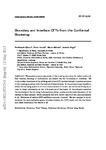Boundary and interface CFTs from the conformal bootstrap
| dc.contributor.author | Gliozzi, F | |
| dc.contributor.author | Liendo, P | |
| dc.contributor.author | Meineri, M | |
| dc.contributor.author | Rago, A | |
| dc.date.accessioned | 2018-11-11T22:17:06Z | |
| dc.date.available | 2018-11-11T22:17:06Z | |
| dc.date.issued | 2015-05 | |
| dc.identifier.issn | 1029-8479 | |
| dc.identifier.issn | 1029-8479 | |
| dc.identifier.other | 36 | |
| dc.identifier.uri | http://hdl.handle.net/10026.1/12757 | |
| dc.description | 40 pages, many figures v2: new results on 3d O(N) bulk spectrum added, one appendix eliminated, typos corrected, references updated. v3: two references to high precision Monte Carlo data added; they nicely agree with our bootstrap calculations. Matches published version. v4: results for the extraordinary transition for N=2,3 removed: see added note | |
| dc.description.abstract |
Abstract: We explore some consequences of the crossing symmetry for defect conformal field theories, focusing on codimension one defects like flat boundaries or interfaces. We study surface transitions of the 3d Ising and other O(N) models through numerical solutions to the crossing equations with the method of determinants. In the extraordinary transition, where the low-lying spectrum of the surface operators is known, we use the bootstrap equations to obtain information on the bulk spectrum of the theory. In the ordinary transition the knowledge of the low-lying bulk spectrum allows to calculate the scale dimension of the relevant surface operator, which compares well with known results of two-loop calculations in 3d. Estimates of various OPE coefficients are also obtained. We also analyze in 4-ϵ dimensions the renormalization group interface between the O(N) model and the free theory and check numerically the results in 3d. | |
| dc.format.extent | 36- | |
| dc.language | en | |
| dc.language.iso | en | |
| dc.publisher | Springer Science and Business Media LLC | |
| dc.subject | Conformal and W Symmetry | |
| dc.subject | Boundary Quantum Field Theory | |
| dc.title | Boundary and interface CFTs from the conformal bootstrap | |
| dc.type | journal-article | |
| dc.type | Article | |
| plymouth.author-url | http://arxiv.org/abs/1502.07217v4 | |
| plymouth.issue | 5 | |
| plymouth.volume | 2015 | |
| plymouth.publisher-url | http://dx.doi.org/10.1007/JHEP05(2015)036 | |
| plymouth.publication-status | Published | |
| plymouth.journal | Journal of High Energy Physics | |
| dc.identifier.doi | 10.1007/jhep05(2015)036 | |
| plymouth.organisational-group | /Plymouth | |
| plymouth.organisational-group | /Plymouth/Faculty of Science and Engineering | |
| plymouth.organisational-group | /Plymouth/Faculty of Science and Engineering/School of Engineering, Computing and Mathematics | |
| plymouth.organisational-group | /Plymouth/Users by role | |
| plymouth.organisational-group | /Plymouth/Users by role/Academics | |
| plymouth.organisational-group | /Plymouth/Users by role/Researchers in ResearchFish submission | |
| dc.identifier.eissn | 1029-8479 | |
| dc.rights.embargoperiod | Not known | |
| rioxxterms.versionofrecord | 10.1007/jhep05(2015)036 | |
| rioxxterms.licenseref.uri | http://www.rioxx.net/licenses/all-rights-reserved | |
| rioxxterms.type | Journal Article/Review | |
| plymouth.funder | New Ideas in Gauge, String and Lattice Theory::STFC |


